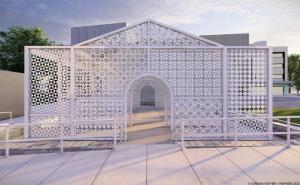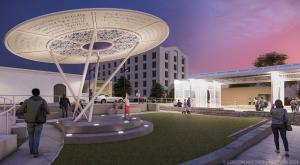
Presence of the Past & Culture Crossing Pavilion art renderings by Gordon Huether unveiled at St. James AMEC Site in TX
Historic site of early African American church in San Antonio set for commemorative artworks in Feb. 2025
Huether, from Napa, CA, unveiled the renderings of the art installation, and Poet Laureate Emeritus Andrea “Vocab” Sanderson, of San Antonio, read a poem inspired by the site's story. The event took place at the St. James AMEC Culture Crossing on West Houston Street.
The first installation, “Presence of the Past,” is an 18-by-36-by-44-foot laser-cut steel artwork echoing the original church structure. Developed through collaborative workshops engaging current AME Church parishioners, San Antonio’s youth, and the general public, Huether’s design draws inspiration from the distinctive façade of the original AME Church as a testament to the lives, worship, and existence of those who once congregated in this space. The perforated metal features historic quilt patterns to guide visitors through the *Presence of the Past,* outlining the façade and rise of the first AME church in San Antonio from 1867-1878. This journey is enriched by the AME shield, symbolizing church doctrine of civil rights, education, economic empowerment, political participation, and public service. The shield leads visitors to an altar that holds the names of the original parishioners, commemorating their contributions.
The second installation, “Culture Crossing Pavilion,” is also laser-cut steel and measures 14-feet high and 23-feet in diameter. Complementing “Presence of the Past”, the “Culture Crossing Pavilion” brings together voices from today’s AME Church and community members across San Antonio and includes works by Sanderson. She collaborated with community members to develop quilt patterns inspired by their individual histories which appear above the dais, creating a vibrant tapestry that tells the story of the community’s past and present. Enveloping the community quilt is a poem by Sanderson.
Current day efforts at the church site’s restoration began after archaeologists uncovered the cornerstone of the church, laid in 1875, during the restoration of San Pedro Creek in 2020.
“Thanks to careful assessment and input from the community, this site will be rehabilitated into a gathering place where people can connect with San Antonio’s dynamic and multi-layered history, honoring the contributions of the diverse ethnic groups that shaped the city’s unique culture,” said Frates Seeligson, Executive Director of the San Antonio River Foundation. “The site remains a tangible landmark of the thriving Reconstruction-era African American community.”
After the Emancipation Proclamation reached Texas in 1865, a group of approximately 100 formerly enslaved individuals and free African-Americans formed a congregation in San Antonio in 1867, guided by the African Methodist Episcopal Church. Initially gathering in each other’s homes, this community had no central place of worship until 1871, when they secured the former Menger Soap Factory on San Pedro Creek. This acquisition established the first physical meeting place for African-Americans and the AMEC in San Antonio, and just the second in Texas.
“We are thrilled with the entire project, from the discovery of the St. James foundation and
cornerstone to the unveiling of this innovative design that creatively and architecturally
preserves the original structures,” said Rev. Cynthia Ladson, pastor at St. James AMEC in San
Antonio.
“St. James AMEC became the first African-American church in San Antonio where worshipers could gather autonomously, free from external restrictions,” said Jim Campbell, Chairman of the Board for the San Antonio River Authority.” The church quickly became a beacon on the west side of San Antonio, championing political participation, education, civil rights, public service, and economic empowerment.”
Its members played significant roles in the community, serving as firefighters, freemasons, postal workers, and even college founders, embodying the spirit of the Free African Society from which the AMEC evolved.
Click here to find out more about the enhancement project or to make a donation, https://www.sariverfound.org/donate/stjamesame
About San Antonio River Foundation
The San Antonio River Foundation is a 501(c)3 non-profit organization whose mission is to preserve, enhance, and transform the San Antonio River Basin as a vibrant cultural, educational, ecological, and recreational experience. Established in 2003, the Foundation was created to provide amenities and enhancements along the San Antonio River and its tributaries, which were not funded by public monies. As part of its mandate, the Foundation raises funds for, invests in, and manages public projects that provide opportunities for residents and city visitors to enjoy the natural beauty of the river and become thoughtful stewards of its future. https://sariverfound.org.
About San Antonio River Authority
The San Antonio River Authority (River Authority) was created by the 45th Texas Legislature on May 5, 1937, and reorganized in 1961 to plan, manage, and implement water-related programs and projects within the San Antonio River Basin. The State of Texas empowered the River Authority to preserve, protect, and manage the resources and the ecology of the San Antonio River and its tributaries. To learn more about the River Authority, visit our website at sariverauthority.org.
About Gordon Huether Studio
Gordon Huether is a Napa, CA-based artist specializing in large-scale, site-specific permanent art installations. With hundreds of works across a decades-long career, Huether's most complex commission to date is the seven architecturally integrated installations for the Salt Lake City International Airport, completing in stages from 2020 to 2024. For more information, visit us at www.gordonhuether.com.
Ron Heckmann
Heckmann Communications
+1 5106525800
email us here
Distribution channels: Building & Construction Industry, Culture, Society & Lifestyle, Education, Real Estate & Property Management, Religion
Legal Disclaimer:
EIN Presswire provides this news content "as is" without warranty of any kind. We do not accept any responsibility or liability for the accuracy, content, images, videos, licenses, completeness, legality, or reliability of the information contained in this article. If you have any complaints or copyright issues related to this article, kindly contact the author above.
Submit your press release

